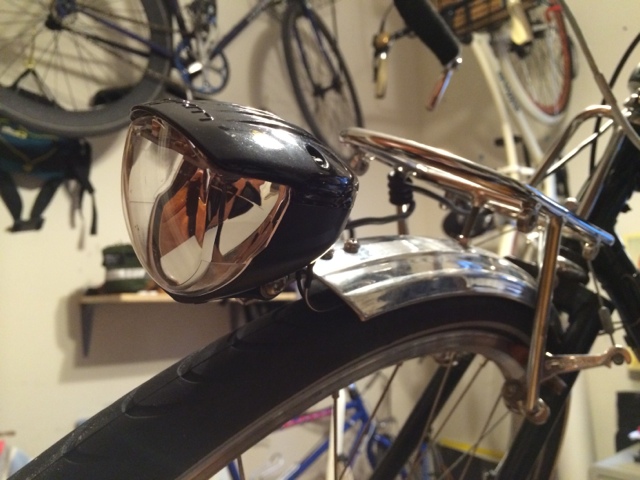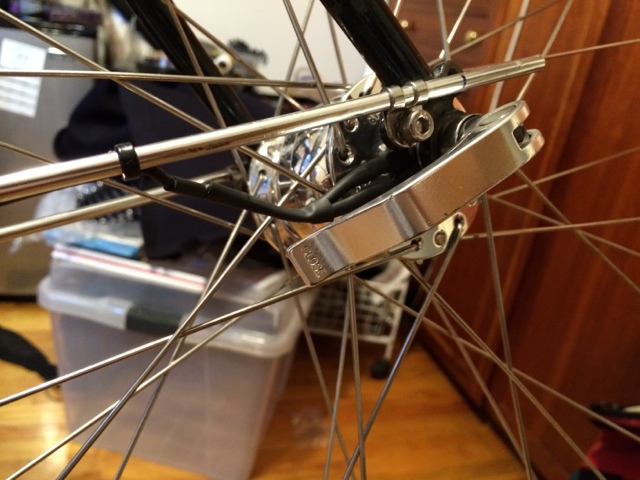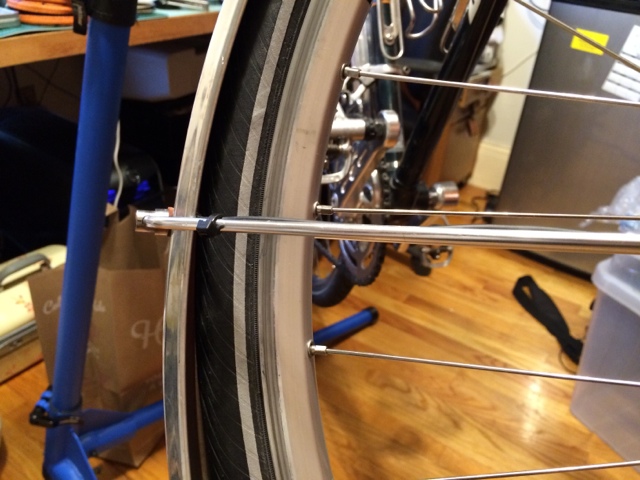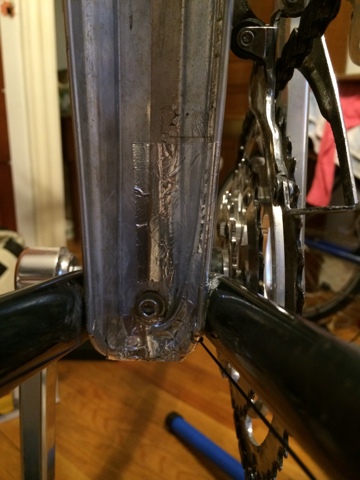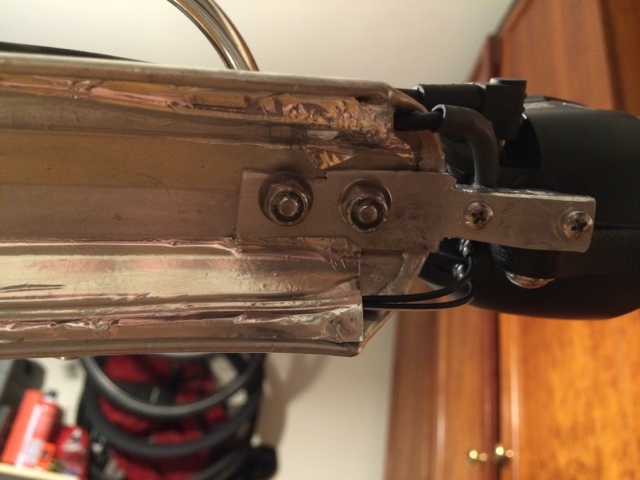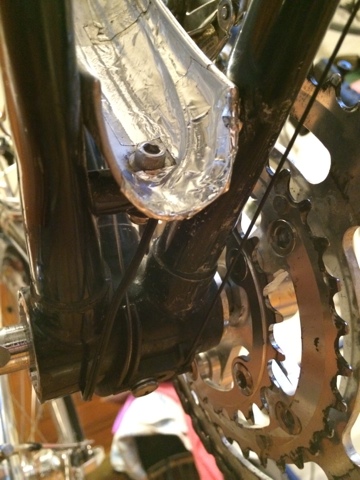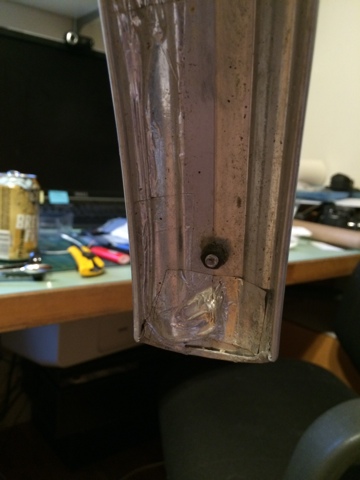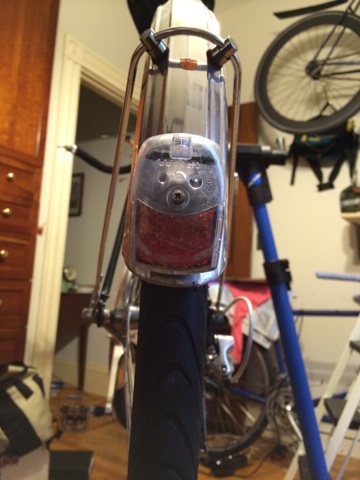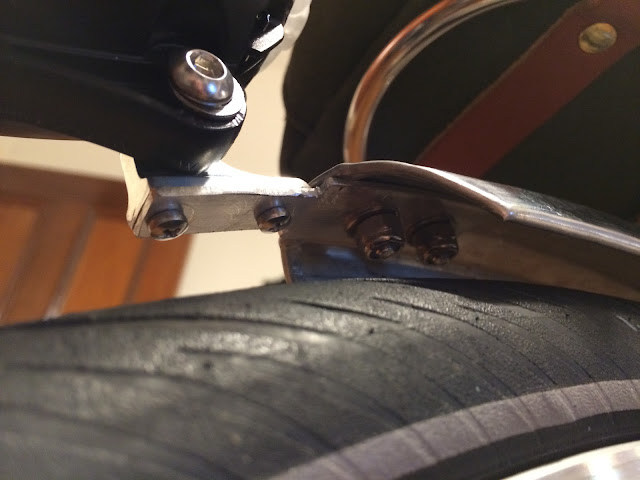I had been on the lookout for a good deal on a tandem when about 1 year ago I spied an old (late '80's-early 90's as far as I can tell) Nashbar Tandem 9000 on Craigslist. If I recall correctly, the person was asking $150-$200 for it. This was already a good deal, as it seems impossible to find someone that believes their shitty tandem is worth anything less than $1000, regardless of condition. Perhaps because it was listed on CL, I felt compelled to see if they would take less. I offered $100, and told the person that I would need for them to deliver it, as I had no way to pick up a bike that I couldn't ride home (the tires were rotted) and while I had three bike racks on the roof of my car none were capable of carrying a tandem (not to mention the person lived far from the city and I didn't feel like schlepping). Amazingly my offer was accepted, and two young guys showed up at my apartment the next evening with the following:
The big blue Nashbar 9000 tandem that was dropped off was in relatively decent structural shape, but as I got deeper into the restoration I realized that -shocker- this was a bike that had actually been ridden by its owners, and quite a lot it seemed.
My first attempt at making this land ship roadworthy was geared towards doing it on the cheap, and so I replaced as little as was necessary:
- I re-cabled and re-housed the drum brake, both rim brakes and both derailers
- I replaced the tubes and rotted tires with Schwalbe Marathon 27 x 1 1/4" rubber (the best 27" tires that I could identify)
- I bought matching honey brown Brooks saddles used on eBay. A B17 for the captain and a Flyer for the rear admiral
- I bought a cheapo seatpost for the rear admiral, as there was none when I got the bike
- I put new Cinelli cork handlebar tape on both sets of handlebars
- I replaced the brake pads on the cantilevers with salmon Kool Stop pads
- I put on rear and front racks that I had lying around
At that point, my wife controlled the drag brake through an aero lever that was mounted to her bars. The other rear lever served as a dummy lever and comfortable place to put her hands.
That was when I got ambitious and decided that we were ready to go cycle touring to and in Acadia National Park.
I borrowed a Burley child trailer from a friend and we hoped to hop the Amtrak Downeaster to the end of the line, at which point we planned on cycling the roughly 150 miles to the park and then exploring the carriage roads on 2 wheels. That crazy setup looked like this:
When I was loading the bike onto the train at South Station in downtown Boston, the conductor mentioned that he didn't think that tandems were allowed in the bike car. I had planned an entire week-long vacation around being able to bring the bike on the train, and had never seen anything mentioning this fact on the Amtrak website, so I argued vociferously that it would be fine and that he was wrong. "Lucky" for me, I won the argument and slid the bike into a diagonally oriented rack that simply held the front wheel. At first I said that due to the length of the steed I wanted to just lay the bike on its side, as I didn't trust the rack, but the conductor wasn't having it. At that point I felt lucky to get the bike on there, so I didn't argue.
When the train pulled into the final destination, the conductor approached me to inform me (in a very deferential and apologetic manner) that something bad had happened to my bike on the ride. I walked back to the bike car to find the front wheel completely taco'd. Apparently the bike had tipped during transit and the front wheel stayed in place, thus the Mexican fiesta in the front.
I think I felt as bad as the conductor. He gave me the phone number of a supervisor to call (the following Monday, it was Saturday at this point) who would take care of reimbursing me for the damage. Owing to my obstinacy, I felt partially responsible. Furthermore, I'm a huge believer in rail travel, and I didn't want to do something that I felt would further damage the already enfeebled finances of Amtrak. If I had felt entirely guiltless, I would not have taken this approach, but I accepted the responsibility that I thought I deserved. My wife was not as understanding (this was our one-and-only one week summer vacation that had potentially been ruined after all).
There was a bike shop very close to the train station, but they did not stock 48-hole 27" rims (imagine!). I was weary of what they had in stock supporting our heavy load.
This is what the bike (and my trooper of a wife) looked like once we got off the train:
I decided that the only way to salvage the vacation was to take the train back to Boston with the tandem, go home, drop off the tandem and put two "regular" bikes on the roof of the car and drive back up. Thus my dreams of a car-free vacation were dashed, but the vacation was salvaged.
The carriage roads of Acadia provide for miles of stress-free riding, and we subsequently had a terrific vacation on 4 wheels instead of two:
| Can't do that with a tandem |
When Velo Orange announced their "Crazy Bars" I immediately decided that I needed two sets of them. I missed out on the first round, but I got in on the second and swapped out both front and rear drops for these very practical (and admittedly bizarre) h'bars.
Only problem was that the OEM quill didn't work with bars like these, so I needed to convert to a threadless-type stem. I originally assumed that the stem was a standard 1" quill, but I was mistaken. This steed takes a somewhat unique 1-1/8" quill. Fortunately, Universal Cycles had a 1-1/8" quill to threadless adapter, to which I attached a Profile Design stem:
I also took the Nitto rando rack that was previously on my commuter and put it on this bike. All I had to do was buy some fork blade clamps (from Bikes Not Bombs).
| Clamps not actually visible in this picture, but they are elsewhere. That's a Rivendell Trunksack. |
In the upright portion, I went with JTek AeroBrake Clamp-on Style levers, as most typical inverse levers require a larger diameter than the roughly 17.6mm that is present on the VO Crazy Bars. Plus, I figured I might as well keep all the brake levers in the same family and I'm always interested in supporting small-scale American bicycle parts manufacturers:
| I subsequently got somewhat Bob-ish and finished the cork bar tape with nylon string (not hemp or cotton...) |
Four brake levers and only two brakes (not including the Arai drag/drum brake which we'll get to later). I originally ordered a DoubleControl Model L from JTek engineering as well, but once I received it I decided that I would like to have the integrated spring that is present in the Problem Solvers version of the same device. I also was not very happy with what appeared to be pretty rough tolerances in the JTek version.
 |
| This image is from JTek's website. You can see their DoubleControl just below where the stem would connect. |
So far it doesn't appear that I need to cinch the doublers to the bars to prevent rattling, but if I do I'll have to figure out something more elgegant than zip-ties, probably twine and do a similar treatment to the ends of the h'bars.
| The brake is engaged in this picture. Using a barcon allows you to have a parking brake, which is very handy with an unwieldy steed like a tandem. |
| The Ritchey Break-Away Quick Disconnect (DERAILER VERSION) is just to the left of the lever arm. |
I replaced the cantilever brakes with Tektro mini-V's, and I pull Kool Stop pads on them (natch). I also ordered Jagwire adjustable noodles as all of the reviews I read of the brakes said they were a worthy addition (and cheap one at that at ~$4 each). The canti's were interfering with my racks, and I read that people liked them, so I figured why not. So far they've been great and they give me plenty of flexibility in pad placement despite the 27"->700c conversion.
| I no longer need the cable hanger that is attached to the seatpost bolt, but I haven't removed it yet. |
Other details that are not particularly photo-worthy:
- Both bottom brackets were replaced with modern, sealed bearing variety. (I actually can't remember what I put in there, but I think they are VO).
- I replaced the freewheel with a modern Shimano 7-speed
- The primary chain was replaced with a SRAM something-or-other
- Al housing and cables were replaced
- The original Suntour barcons were replaced with Shimano friction shifters. I've since learned that the Suntour barcons are relatively desirable. I don't know why, as I found them to be inferior to Shimano. I sold them on eBay. I also removed the Suntour cantilever brakes, as they no longer reached after the 700c conversion. I'm going to sell them, I just haven't yet.
- I put on four generic silver aluminum bottle cages
- the pedals are constantly changing
- the original Suntour F&R derailers remain for the time being, as do the triple chainrings.
We're ready for rando season!
Hope to see you at some NER events this spring, and hopefully at PBP 2015...
I had been on the lookout for a good deal on a tandem when about 1 year ago I spied an old (late '80's-early 90's as far as I can tell) Nashbar Tandem 9000 on Craigslist. If I recall correctly, the person was asking $150-$200 for it. This was already a good deal, as it seems impossible to find someone that believes their shitty tandem is worth anything less than $1000, regardless of condition. Perhaps because it was listed on CL, I felt compelled to see if they would take less. I offered $100, and told the person that I would need for them to deliver it, as I had no way to pick up a bike that I couldn't ride home (the tires were rotted) and while I had three bike racks on the roof of my car none were capable of carrying a tandem (not to mention the person lived far from the city and I didn't feel like schlepping). Amazingly my offer was accepted, and two young guys showed up at my apartment the next evening with the following:
The big blue Nashbar 9000 tandem that was dropped off was in relatively decent structural shape, but as I got deeper into the restoration I realized that -shocker- this was a bike that had actually been ridden by its owners, and quite a lot it seemed.
My first attempt at making this land ship roadworthy was geared towards doing it on the cheap, and so I replaced as little as was necessary:
- I re-cabled and re-housed the drum brake, both rim brakes and both derailers
- I replaced the tubes and rotted tires with Schwalbe Marathon 27 x 1 1/4" rubber (the best 27" tires that I could identify)
- I bought matching honey brown Brooks saddles used on eBay. A B17 for the captain and a Flyer for the rear admiral
- I bought a cheapo seatpost for the rear admiral, as there was none when I got the bike
- I put new Cinelli cork handlebar tape on both sets of handlebars
- I replaced the brake pads on the cantilevers with salmon Kool Stop pads
- I put on rear and front racks that I had lying around
At that point, my wife controlled the drag brake through an aero lever that was mounted to her bars. The other rear lever served as a dummy lever and comfortable place to put her hands.
That was when I got ambitious and decided that we were ready to go cycle touring to and in Acadia National Park.
I borrowed a Burley child trailer from a friend and we hoped to hop the Amtrak Downeaster to the end of the line, at which point we planned on cycling the roughly 150 miles to the park and then exploring the carriage roads on 2 wheels. That crazy setup looked like this:
When I was loading the bike onto the train at South Station in downtown Boston, the conductor mentioned that he didn't think that tandems were allowed in the bike car. I had planned an entire week-long vacation around being able to bring the bike on the train, and had never seen anything mentioning this fact on the Amtrak website, so I argued vociferously that it would be fine and that he was wrong. "Lucky" for me, I won the argument and slid the bike into a diagonally oriented rack that simply held the front wheel. At first I said that due to the length of the steed I wanted to just lay the bike on its side, as I didn't trust the rack, but the conductor wasn't having it. At that point I felt lucky to get the bike on there, so I didn't argue.
When the train pulled into the final destination, the conductor approached me to inform me (in a very deferential and apologetic manner) that something bad had happened to my bike on the ride. I walked back to the bike car to find the front wheel completely taco'd. Apparently the bike had tipped during transit and the front wheel stayed in place, thus the Mexican fiesta in the front.
I think I felt as bad as the conductor. He gave me the phone number of a supervisor to call (the following Monday, it was Saturday at this point) who would take care of reimbursing me for the damage. Owing to my obstinacy, I felt partially responsible. Furthermore, I'm a huge believer in rail travel, and I didn't want to do something that I felt would further damage the already enfeebled finances of Amtrak. If I had felt entirely guiltless, I would not have taken this approach, but I accepted the responsibility that I thought I deserved. My wife was not as understanding (this was our one-and-only one week summer vacation that had potentially been ruined after all).
There was a bike shop very close to the train station, but they did not stock 48-hole 27" rims (imagine!). I was weary of what they had in stock supporting our heavy load.
This is what the bike (and my trooper of a wife) looked like once we got off the train:
I decided that the only way to salvage the vacation was to take the train back to Boston with the tandem, go home, drop off the tandem and put two "regular" bikes on the roof of the car and drive back up. Thus my dreams of a car-free vacation were dashed, but the vacation was salvaged.
The carriage roads of Acadia provide for miles of stress-free riding, and we subsequently had a terrific vacation on 4 wheels instead of two:
| Can't do that with a tandem |
When Velo Orange announced their "Crazy Bars" I immediately decided that I needed two sets of them. I missed out on the first round, but I got in on the second and swapped out both front and rear drops for these very practical (and admittedly bizarre) h'bars.
Only problem was that the OEM quill didn't work with bars like these, so I needed to convert to a threadless-type stem. I originally assumed that the stem was a standard 1" quill, but I was mistaken. This steed takes a somewhat unique 1-1/8" quill. Fortunately, Universal Cycles had a 1-1/8" quill to threadless adapter, to which I attached a Profile Design stem:
I also took the Nitto rando rack that was previously on my commuter and put it on this bike. All I had to do was buy some fork blade clamps (from Bikes Not Bombs).
| Clamps not actually visible in this picture, but they are elsewhere. That's a Rivendell Trunksack. |
In the upright portion, I went with JTek AeroBrake Clamp-on Style levers, as most typical inverse levers require a larger diameter than the roughly 17.6mm that is present on the VO Crazy Bars. Plus, I figured I might as well keep all the brake levers in the same family and I'm always interested in supporting small-scale American bicycle parts manufacturers:
| I subsequently got somewhat Bob-ish and finished the cork bar tape with nylon string (not hemp or cotton...) |
Four brake levers and only two brakes (not including the Arai drag/drum brake which we'll get to later). I originally ordered a DoubleControl Model L from JTek engineering as well, but once I received it I decided that I would like to have the integrated spring that is present in the Problem Solvers version of the same device. I also was not very happy with what appeared to be pretty rough tolerances in the JTek version.
 |
| This image is from JTek's website. You can see their DoubleControl just below where the stem would connect. |
So far it doesn't appear that I need to cinch the doublers to the bars to prevent rattling, but if I do I'll have to figure out something more elgegant than zip-ties, probably twine and do a similar treatment to the ends of the h'bars.
| The brake is engaged in this picture. Using a barcon allows you to have a parking brake, which is very handy with an unwieldy steed like a tandem. |
| The Ritchey Break-Away Quick Disconnect (DERAILER VERSION) is just to the left of the lever arm. |
I replaced the cantilever brakes with Tektro mini-V's, and I pull Kool Stop pads on them (natch). I also ordered Jagwire adjustable noodles as all of the reviews I read of the brakes said they were a worthy addition (and cheap one at that at ~$4 each). The canti's were interfering with my racks, and I read that people liked them, so I figured why not. So far they've been great and they give me plenty of flexibility in pad placement despite the 27"->700c conversion.
| I no longer need the cable hanger that is attached to the seatpost bolt, but I haven't removed it yet. |
Other details that are not particularly photo-worthy:
- Both bottom brackets were replaced with modern, sealed bearing variety. (I actually can't remember what I put in there, but I think they are VO).
- I replaced the freewheel with a modern Shimano 7-speed
- The primary chain was replaced with a SRAM something-or-other
- Al housing and cables were replaced
- The original Suntour barcons were replaced with Shimano friction shifters. I've since learned that the Suntour barcons are relatively desirable. I don't know why, as I found them to be inferior to Shimano. I sold them on eBay. I also removed the Suntour cantilever brakes, as they no longer reached after the 700c conversion. I'm going to sell them, I just haven't yet.
- I put on four generic silver aluminum bottle cages
- the pedals are constantly changing
- the original Suntour F&R derailers remain for the time being, as do the triple chainrings.
We're ready for rando season!
Hope to see you at some NER events this spring, and hopefully at PBP 2015...
 |
| Spring is finally here. For those of us that have been riding through the winter, it is refreshing to begin to feel comfortable leaving (some of) the layers at home. |
 |
| There is nothing quite like riding through the city, noticing all the birds and flowers that are returning. |
| So get on your bike this afternoon (Friday March 29) and come to Copley Sq at 5:45pm for a bicycling celebration. |
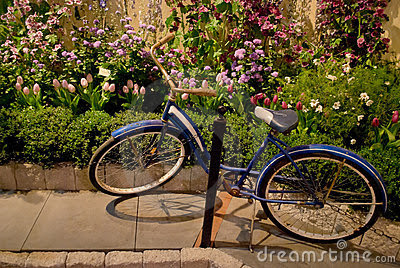 |
| See you there. |
 |
| Spring is finally here. For those of us that have been riding through the winter, it is refreshing to begin to feel comfortable leaving (some of) the layers at home. |
 |
| There is nothing quite like riding through the city, noticing all the birds and flowers that are returning. |
| So get on your bike this afternoon (Friday March 29) and come to Copley Sq at 5:45pm for a bicycling celebration. |
 |
| See you there. |
| Resurrected 1994 Bridgestone RB-T |
| 1994 Bridgestone Catalog Page (from Sheldonbrown.com) |
I subsequently moved to Atlanta for grad school and I brought the Rock Hopper rather than the RB-T. I didn't ride much while I lived there as that city is so car-centric. Were I to live there now I would ride, but at the time it just wasn't part of my plan.
I moved back to Boston in 2006, settling into life in JP. I began riding regularly within 6 months-or-so and I retrieved the Bridgestone from the basement and it became my primary ride for a while. The wheels were screwed up and I bought some Ritchey deep-section wheels with bladed spokes from Nashbar that ultimately looked ridiculous on it. I then built up a fixed-gear and that became my primary ride during my blossoming bike obsession over the following 5 years.
| A Beauty Reborn |
The pictures here are of the completed project. It is the first bike that I have ever built entirely by myself from the ground up (not including the frame (obviously) and the wheels which I had built for me). It was an amazingly fun activity, and was all the more rewarding considering that I rode this bike across the country so there is obviously some sentimental attachment. While this might be heresy for some who think that bikes like this should be restored with period perfect parts: I actually think the bike is more beautiful than it was the day it was new, and any parts that I have added (as opposed to reusing) are certainly superior to the original equipment.
So here is the part-by-part breakdown of my rebuild:
| Tange double butted tubing on the RB-T. The paint is in remarkably good condition considering that the bike is almost 20 years old. |
| Mavic A319 rims are new. Double-butted stainless steel spokes with brass nipples laced to... |
| Ultegra 32H front hub laced 3X, and... |
| Ultegra 32H rear hub laced 3X. These wheels were hand-built by www.bicyclewheelwarehouse.com. I would have preferred to have them built locally, but I saved a ton of money on these and I was already spending too much money as it was. I still need to cut the fender stays. |
| American made Paul Components Touring Canti with polished finish up front. Another serious upgrade from the original brakes. Front fender is a 52mm Velo Orange Zeppelin. The headset is original, mainly because it seems like it is in decent shape, I serviced it with the help of Broadway Bicycle School a number of years ago, and I don't have the proper tools to remove it myself. If this one ever needs replacing, I'll put a Chris King in there. |
| Brooks B17 saddle. This is much better than the Avocet saddle that the bike came with. That thing made it hurt to pee! |
| A little Japanese flair: an NJS stamped Nitto Jaguar SP-72 27.0mm seatpost that I ordered off Ebay from a guy that sells used Kerin gear. You know you are a bike dork when you get excited about a seatpost, and this one is a beauty. I have a Jaguar on my Iglehart (in 27.2mm guise) too and it is much more appropriate for this bike than a Thompson IMHO. The original seatpost was an ugly cheapo giveaway. All parts that I did not reuse that were still functional were given to Bikes Not Bombs. The brake cable hanger is original. The kitty sticker is not. |
| I used 3 of the screws that typically go on a presta valve and some of the extra leather washers I had. This is rock solid so far, and looks pretty killer if you ask me. |
| From the front |
| From the back |
| I couldn't be more pleased! See you on the road. |
| Resurrected 1994 Bridgestone RB-T |
| 1994 Bridgestone Catalog Page (from Sheldonbrown.com) |
I subsequently moved to Atlanta for grad school and I brought the Rock Hopper rather than the RB-T. I didn't ride much while I lived there as that city is so car-centric. Were I to live there now I would ride, but at the time it just wasn't part of my plan.
I moved back to Boston in 2006, settling into life in JP. I began riding regularly within 6 months-or-so and I retrieved the Bridgestone from the basement and it became my primary ride for a while. The wheels were screwed up and I bought some Ritchey deep-section wheels with bladed spokes from Nashbar that ultimately looked ridiculous on it. I then built up a fixed-gear and that became my primary ride during my blossoming bike obsession over the following 5 years.
| A Beauty Reborn |
The pictures here are of the completed project. It is the first bike that I have ever built entirely by myself from the ground up (not including the frame (obviously) and the wheels which I had built for me). It was an amazingly fun activity, and was all the more rewarding considering that I rode this bike across the country so there is obviously some sentimental attachment. While this might be heresy for some who think that bikes like this should be restored with period perfect parts: I actually think the bike is more beautiful than it was the day it was new, and any parts that I have added (as opposed to reusing) are certainly superior to the original equipment.
So here is the part-by-part breakdown of my rebuild:
| Tange double butted tubing on the RB-T. The paint is in remarkably good condition considering that the bike is almost 20 years old. |
| Mavic A319 rims are new. Double-butted stainless steel spokes with brass nipples laced to... |
| Ultegra 32H front hub laced 3X, and... |
| Ultegra 32H rear hub laced 3X. These wheels were hand-built by www.bicyclewheelwarehouse.com. I would have preferred to have them built locally, but I saved a ton of money on these and I was already spending too much money as it was. I still need to cut the fender stays. |
| American made Paul Components Touring Canti with polished finish up front. Another serious upgrade from the original brakes. Front fender is a 52mm Velo Orange Zeppelin. The headset is original, mainly because it seems like it is in decent shape, I serviced it with the help of Broadway Bicycle School a number of years ago, and I don't have the proper tools to remove it myself. If this one ever needs replacing, I'll put a Chris King in there. |
| Brooks B17 saddle. This is much better than the Avocet saddle that the bike came with. That thing made it hurt to pee! |
| A little Japanese flair: an NJS stamped Nitto Jaguar SP-72 27.0mm seatpost that I ordered off Ebay from a guy that sells used Kerin gear. You know you are a bike dork when you get excited about a seatpost, and this one is a beauty. I have a Jaguar on my Iglehart (in 27.2mm guise) too and it is much more appropriate for this bike than a Thompson IMHO. The original seatpost was an ugly cheapo giveaway. All parts that I did not reuse that were still functional were given to Bikes Not Bombs. The brake cable hanger is original. The kitty sticker is not. |
| I used 3 of the screws that typically go on a presta valve and some of the extra leather washers I had. This is rock solid so far, and looks pretty killer if you ask me. |
| From the front |
| From the back |
| I couldn't be more pleased! See you on the road. |
| Resurrected 1994 Bridgestone RB-T |
| 1994 Bridgestone Catalog Page (from Sheldonbrown.com) |
I subsequently moved to Atlanta for grad school and I brought the Rock Hopper rather than the RB-T. I didn't ride much while I lived there as that city is so car-centric. Were I to live there now I would ride, but at the time it just wasn't part of my plan.
I moved back to Boston in 2006, settling into life in JP. I began riding regularly within 6 months-or-so and I retrieved the Bridgestone from the basement and it became my primary ride for a while. The wheels were screwed up and I bought some Ritchey deep-section wheels with bladed spokes from Nashbar that ultimately looked ridiculous on it. I then built up a fixed-gear and that became my primary ride during my blossoming bike obsession over the following 5 years.
| A Beauty Reborn |
The pictures here are of the completed project. It is the first bike that I have ever built entirely by myself from the ground up (not including the frame (obviously) and the wheels which I had built for me). It was an amazingly fun activity, and was all the more rewarding considering that I rode this bike across the country so there is obviously some sentimental attachment. While this might be heresy for some who think that bikes like this should be restored with period perfect parts: I actually think the bike is more beautiful than it was the day it was new, and any parts that I have added (as opposed to reusing) are certainly superior to the original equipment.
So here is the part-by-part breakdown of my rebuild:
| Tange double butted tubing on the RB-T. The paint is in remarkably good condition considering that the bike is almost 20 years old. |
| Mavic A319 rims are new. Double-butted stainless steel spokes with brass nipples laced to... |
| Ultegra 32H front hub laced 3X, and... |
| Ultegra 32H rear hub laced 3X. These wheels were hand-built by www.bicyclewheelwarehouse.com. I would have preferred to have them built locally, but I saved a ton of money on these and I was already spending too much money as it was. I still need to cut the fender stays. |
| American made Paul Components Touring Canti with polished finish up front. Another serious upgrade from the original brakes. Front fender is a 52mm Velo Orange Zeppelin. The headset is original, mainly because it seems like it is in decent shape, I serviced it with the help of Broadway Bicycle School a number of years ago, and I don't have the proper tools to remove it myself. If this one ever needs replacing, I'll put a Chris King in there. |
| Brooks B17 saddle. This is much better than the Avocet saddle that the bike came with. That thing made it hurt to pee! |
| A little Japanese flair: an NJS stamped Nitto Jaguar SP-72 27.0mm seatpost that I ordered off Ebay from a guy that sells used Kerin gear. You know you are a bike dork when you get excited about a seatpost, and this one is a beauty. I have a Jaguar on my Iglehart (in 27.2mm guise) too and it is much more appropriate for this bike than a Thompson IMHO. The original seatpost was an ugly cheapo giveaway. All parts that I did not reuse that were still functional were given to Bikes Not Bombs. The brake cable hanger is original. The kitty sticker is not. |
| I used 3 of the screws that typically go on a presta valve and some of the extra leather washers I had. This is rock solid so far, and looks pretty killer if you ask me. |
| From the front |
| From the back |
| I couldn't be more pleased! See you on the road. |
Gov. Patrick has banned all vehicular traffic after 4pm in THE WHOLE STATE! Woo hoo. Throw those Marathon Winter studded tires on your steed (if you have not already done so) and get out there and ride. My commute this morning to work was a breeze and I’m pumped for the ride home.

